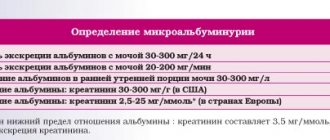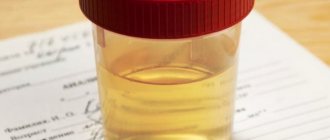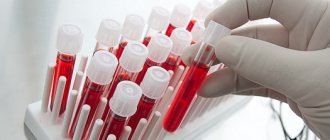What does it show
1 ml of blood of a healthy person contains 1-3 mg of sugar. This amount of carbohydrate corresponds to about 50 units. amylase activity. During the day, the normal concentration of the enzyme fluctuates, remaining relatively low.
Diastase is found in large quantities only in the digestive tract, although the fallopian tubes, ovaries and liver also have some amylase activity. When the tissues that produce it are damaged, amylase is released into the blood, and after the bloodstream is cleansed by the kidneys, it enters the urine.
Thus, urine analysis for diastase is a diagnostically important sign of disorders of the glands and the integrity of the gastrointestinal tract. Abnormal results may indirectly indicate high blood sugar and kidney disease, which cause increased concentrations of amylase in the urine while maintaining normal levels in the bloodstream.
Some experts point out that dystasuria (the presence of diastase in the urine) is not a mandatory sign of pancreatitis, since the enzyme content, even during an acute process, can vary widely. In the presence of clinical signs of gastrointestinal diseases, repeated studies of alpha-amylase concentration are important.
Urine analysis for diastase is a diagnostically important sign of disorders of the glands and the integrity of the gastrointestinal tract.
Measuring daily urine output
Target. Study of water metabolism in the body. Indications. Violation of circulatory and urinary processes. Equipment. 3L jar with label; pot with label; volumetric flask; fluid intake sheet. Technique for measuring daily diuresis : 1. The night before, the patient is informed about the upcoming study. They explain in detail that tomorrow morning at 6.00 he needs to urinate in the toilet and go to the guard nurse to measure his body weight. All subsequent urinations during the day (until the morning of the next day) must be performed by the patient in a pot and poured into a jar. The patient must do the last urination into the jar at 6.00 am the next day and re-approach the guard nurse to be weighed. In addition, starting tomorrow morning, during the day, the patient must take into account the amount of fluid he drinks, as well as the fruits, vegetables and liquid meals he eats. The amount of liquid as you consume it must be recorded in the “Liquid Drinking Sheet”. Medium-sized fruits and vegetables are considered to be 100 g of liquid. 2. After 24 hours, the nurse needs to measure the amount of urine in a three-liter jar, calculate the amount of liquid drunk and note these data, as well as the patient’s body weight before the study and at the end of it in the temperature sheet in the appropriate columns. Note. If the patient is elderly or weakened, then the nurse herself records the fluid consumed.
Norm
Normal indicators of diastase analysis depend on the sensitivity of the reagents and the accuracy of the research methodology. Doctors recommend using the services of one laboratory so that monitoring changes in the level of the substance is as accurate as possible.
In adults
The normal level of diastase in the blood is about 80 U/L (up to 128 U/L depending on the reference values of the research center). In urine, the enzyme is present in a more concentrated state, so its amount in a healthy person can reach 600-800 U/l.
Laboratory reference values can range from 24 to 350-400 U/l, 1-17 U/h (Invitro) or 450-490 IU, depending on the gender of the patient.
Specifics in women
The specificity of the study in patients is the low amylase activity of the ovaries and fallopian tubes, which reduces the accuracy of the analysis. Minor changes in the indicator can be observed with neoplasms of the female reproductive glands, as well as with conditions associated with pregnancy.
During pregnancy, there may be minor changes in the indicator.
During pregnancy
During gestation, the level of diastase in the blood and urine is physiologically slightly increased. An increase in the number of enzyme units accompanies a tubal (ectopic) pregnancy and is observed after its termination.
The state of early toxicosis is accompanied by a decrease in amylase concentration. With gestosis, a complication of pregnancy that can occur after 20 weeks of gestation, the value of the indicator increases.
Normal enzyme levels in children
The normal level of diastase for a child 6 years of age and older may not differ from that for an adult patient. However, the norm established by doctors does not exceed 600 U/l. In young children, especially newborns and infants, the concentration of alpha-amylase may be much lower than normal: this is due to the low enzymatic activity of the glands in the first months of a baby’s life.
Pancreatic enzymes are a set of active substances that ensure the digestion process. Their types and functions.
Taking urine for acetone
Target. Determination of acetone bodies in urine. Indications. Diabetes; starvation; fever; low-carbohydrate diet; some forms of malignant neoplasms. Equipment. Clean dry jar with a capacity of 200 ml; referral to the laboratory; clean dry pot with label; kit for washing when collecting urine from a seriously ill patient. Technique for collecting urine for acetone : 1. The night before, the patient is informed about the upcoming study. He is told that tomorrow morning from 6.00 to 7.00, after a thorough toilet, he must urinate in a pot or a vessel, pour some of the urine into a jar with a direction and leave it in the sanitary room. 2. The nurse is required to deliver urine to the biochemical laboratory. 3. The result of the study is pasted into the medical history. Notes. If the patient is on bed rest, a nurse washes and collects urine from the vessel. Normally, there is no acetone in urine.
Deviations from the norm
The diagnostic value of deviations from the normal level of diastase in the urine directly depends on compliance with the rules for collecting and storing biomaterial, the presence of symptoms of pancreatitis (other gastrointestinal diseases) and concomitant renal, hepatic and metabolic pathologies in the patient.
Minor deviations do not always indicate inflammation of the digestive tract. They occur in a state of pregnancy or acclimatization, with a certain diet, after drinking alcohol, during drug therapy.
Is it possible to drink alcohol with pancreatitis and in what quantities read the next article.
Minor deviations do not always indicate inflammation of the digestive tract. They occur in a state after drinking alcohol.
Main causes of violations
Despite the large number of factors influencing the result, doctors confidently identify a list of the main reasons for deviations in diastase concentrations. These include:
- inflammation and other pathologies of the secreting glands;
- cholecystitis;
- malignant neoplasia of the peritoneal organs;
- diabetes mellitus (ketoacidosis);
- exacerbation of gastrointestinal ulcers, urolithiasis and cholelithiasis;
- intestinal obstruction;
- abdominal injuries;
- poisoning and alcoholism;
- hepatitis;
- appendicitis;
- acute course of thyrotoxicosis;
- intestinal obstruction;
- hereditary pathology of glands secreting diastase (cystic fibrosis);
- congenital deficiency of digestive enzymes and gland dysfunction;
- renal failure, etc.
How to help the pancreas with high blood sugar: diet, folk remedies.
Despite the large number of factors influencing the result, doctors identify several causes of exacerbation of gastrointestinal ulcers, urolithiasis and cholelithiasis.
Increased value
An increase in the concentration of diastase in urine may be due to the following reasons:
- acute and reactive pancreatitis, exacerbation of a chronic inflammatory process;
- ketoacidosis;
- inflammation of the salivary glands due to mumps (mumps);
- appendicitis and peritonitis;
- the presence of a cyst in the pancreas or a mechanical obstruction in its duct (this could be a stone, tumor or adhesion);
- gallbladder diseases;
- renal failure, infectious processes in the kidneys;
- inflammation of the colon mucosa (colitis);
- oncological diseases of the pancreas and thyroid glands, ovaries, lungs, intestines, genitourinary system (uterus, prostate);
- ectopic pregnancy;
- peptic ulcers of the gastrointestinal tract in the acute stage, severe abdominal injuries, damage to the wall of a hollow organ (including the pancreas), condition after surgery on the peritoneum;
- taking drugs, alcoholism.
An increase in the concentration of diastase in the urine may be due to acute and reactive pancreatitis, exacerbation of a chronic inflammatory process.
Drug therapy can also provoke an increase in the concentration of diastase in the body. The enzyme level is affected by tetracycline antibiotics, NSAIDs, anticancer drugs, some analgesics, adrenaline, corticosteroids, salicylic acid compounds, diuretics and birth control pills.
Despite the large number of possible reasons for the deviation of the result upward, the analysis is considered a fairly accurate marker of inflammation of the pancreas: the highest concentration of alpha-amylase in urine (more than tens of times higher than normal) is observed in acute pancreatitis.
Reduced rate
A reduced concentration of diastase can be observed in the following pathologies:
- hepatitis of various etiologies;
- cystic fibrosis;
- chronic pancreatitis with the development of pancreatic insufficiency;
- malignant tumors that affect secretory tissue;
- pancreatic necrosis;
- thyrotoxicosis;
- increased levels of cholesterol in the blood;
- myocardial infarction.
A reduced concentration of diastase can be observed during myocardial infarction.
Low levels of alpha-amylase are typical for infants (children under 1 year of age) and in patients who have undergone pancreatectomy (partial or complete removal of the pancreas). The reason for the decrease in the number of enzyme units may also be early toxicosis of pregnancy and a carbohydrate diet.
A slightly reduced level of diastase in the urine can be observed with macroamylasemia, a condition in which diastase is present in the blood as a chemical complex with other proteins. This pathology occurs in 5-20 people out of 1000, most often not accompanied or caused by diseases of the pancreas and gastrointestinal tract. The enzyme content in the blood serum can vary in any direction depending on the type of disease.
Taking urine for a sample according to Zimnitsky
Target. Determination of water excretion and concentration functions of the kidneys Indications. Violation of the processes of blood circulation and urine formation. Equipment. Clean dry glass jars made of transparent glass with a capacity of 500 ml - 8 pcs.; directions for each jar with a clear indication of the portion number and time of urination - 8 pcs.; clean dry pot with directions; fluid intake sheet. Technique for collecting urine for a sample according to Zimnitsky : 1. Having received the appointment, prepare the dishes, stick the directions, put the jars in the designated place. 2. The night before, the patient is prepared as follows: “You have been assigned a urine test according to Zimnitsky. Tomorrow morning at 6.00 you need to urinate in the toilet and go to the nurse to measure your body weight. Then you need to collect urine every 3 hours during the day (after urinating in the pot, pour it into the appropriate jar), namely: at 9.00: 12.00; 15.00; 18.00; 21.00; 24.00; 3.00; 6.00. If there is no urine in any of the portions, the jar remains empty. After receiving the last eighth portion at 6.00 the next day, you need to go back to the nurse's post to be weighed. In addition, you need to record the amount of fluid you drink per day on a record sheet.” 3. The patient is warned that he will be awakened to obtain nightly portions of urine. The night nurse must also be warned about this by making an entry in the Handover Log. 4. In the morning, all urine is delivered to the clinical laboratory, the amount of liquid drunk is calculated, and the weighing data and the liquid drunk are noted on the temperature sheet. 5. The result obtained from the laboratory is pasted into the medical history. Notes. During the study, the amount and relative density of urine are determined in each portion, and daytime, nighttime and daily diuresis are calculated. The test is carried out under normal eating and drinking conditions.
Preparation
The process of preparing for the study involves the following measures:
- avoiding sweets, alcohol, mineral water, and brightly colored foods a few days before the test;
- discontinuation of drugs that affect the accuracy of the study (NSAIDs, analgesics, hormonal contraceptives, diuretics, etc.) if possible, and informing the doctor conducting the analysis if the drugs are vital;
- cessation of physical activity the day before sampling.
Why may diastasis in urine be increased?
Deviation from standard values of diastase concentration in urine may indicate the presence of a number of diseases:
- pancreatitis;
- cholecystitis;
- peritonitis;
- diabetes mellitus;
- kidney dysfunction;
- acute appendicitis;
- inflammatory processes localized in the oral area, intestines or organs of the reproductive system;
- oncology;
- alcohol or drug poisoning;
- mumps;
- sialadenitis.
No less informative for making a diagnosis are decreased amylase levels that occur against the background of:
- chronic pancreatitis;
- hepatitis A;
- early toxicosis during pregnancy.
A decrease in amylase levels can also be triggered by surgical removal of the pancreas, trauma to the peritoneal organs, or the presence of a genetic disease - cystic fibrosis.
Obtaining the results of urine diastase analysis does not allow for independent interpretation by the patient. Only a highly qualified medical specialist can assess deviations in indicators, draw conclusions and prescribe the necessary course of treatment, who can also prescribe an additional examination (biochemical blood test, ultrasound of the abdominal cavity, stool analysis, etc.).
An integrated approach to diagnosis is the key to reliable definition of the disease, assessment of its severity (acute phase or chronic period) and selection of an adequate treatment regimen.
Collection and delivery algorithm
To ensure maximum accuracy of the research results, it is necessary to follow the rules for preparing and collecting biomaterial:
- Before emptying your bladder, you should thoroughly wash your genitals with warm water.
- The biomaterial for analysis is collected in a special sterile container. Depending on the purpose, a fresh sample or 24-hour urine may need to be collected. It is correct to transfer still warm biomaterial to the research center: then the result will be accurate.
- To determine the level of diastase, you need to take the entire morning or daily portion of urine (depending on the purpose, it may be recommended to bring a general urine test, i.e. 20-30 ml of an average portion).
To determine the level of diastase, you need to give the entire morning or daily portion of urine.
Taking urine for the Addis-Kakovsky test
Target. Determination of the number of shaped elements and cylinders. Indications. Inflammatory kidney diseases. Equipment. Volumetric flask (or 1 liter jar); a clean, dry potty (or bedpan for patients on bed rest); referral to a clinical laboratory. Technique for collecting urine for the Addis-Kakovsky test : 1. After selecting prescriptions from the medical history, prepare a direction and dishes. 2. The patient is prepared for the study as follows: “You have been assigned a urine test according to Addis-Kakovsky. Today at 22.00 you need to urinate in the toilet and hold urination until 8.00 the next morning. In the morning at 8.00, be sure to thoroughly wash yourself and urinate in the pot, and then pour all the urine into a volumetric flask. Leave the flask on the shelf in the sanitary room.” 3. It is necessary to foresee possible urination in the patient during the night and warn him about the mandatory toileting of the genitals before each urination, and add a preservative (thymol or formaldehyde) to the volumetric flask, in order to avoid destruction of the formed elements. 4. Urine should be delivered for examination immediately after urination in a warm state. 5. The result of the study is pasted into the medical history. Notes. If the examination is prescribed for a woman and the patient has vaginal discharge, then it is necessary to cover it with a clean cotton swab. If the patient is on bed rest, the nurse performs toileting of the genitals, having previously prepared everything necessary for washing. With a special prescription from a doctor, the nurse herself carries out washing according to the accepted method, followed by catheterization of the bladder. Normally, when examined using the Addis-Kakovsky test, the urine contains: leukocytes - up to 2 million; red blood cells - up to 1 million; cylinders - up to 20,000.
Method of determination
Urine testing for diastase is carried out using the enzymatic-colorimetric method. It is based on the process of digesting starch with a substance intended for this purpose and further determining the amount of residual carbohydrate in samples of biological material.
For research, 15 test tubes with urine samples in different dilutions are installed in a stand. A starch solution is added to them, after which all containers are placed in a water bath for 15 minutes. After this, a small amount of iodine is added to them, which reacts with the residual starch.
The conclusion about the concentration of diastase is made by quantitative determination of starch, which can be digested in 1 ml of the patient’s urine.
Hemotest
For a hemotest for diastasis, blood serum is used.
Taking urine for general analysis.
Target. Studying the composition of urine. Indications. As a rule, it is performed on all patients admitted for inpatient treatment. Equipment. A clean, dry, clear glass jar with a clinical laboratory directions attached to it; pot with label. Technique for collecting urine for general analysis : 1. The night before, warn the patient about the upcoming study. They explain that tomorrow morning from 6.00 to 7.00, after thoroughly toileting the genitals, he needs to urinate in a pot and pour about 200 ml of urine into a jar. He must leave the jar of urine in a certain place. 2. In the morning, the nurse should check whether the urine has been collected and send it to the laboratory. 3. When the result arrives from the laboratory, it is pasted into the medical history in a certain place. Note. If the patient is on bed rest, then two vessels must be prepared. First, the nurse should wash the patient and, holding out a clean, dry vessel, ask him to urinate into it. She then pours the urine into a jar and sends it to the laboratory. To better organize the work, you need to involve a nurse.
Decoding the results
A specialist should decipher the results. It takes into account medical history data, a list of medications taken and reference values specified in the form.
A specialist should decipher the results.
8 units
A reduced value may indicate pancreatic insufficiency, renal or hepatic pathology. In infants, such a concentration of the enzyme may indicate cystic fibrosis with the appropriate clinical picture.
32 units
This indicator corresponds to the normal level of amylase in both urine and blood serum.
128 units
Corresponds to the normal concentration of diastase.
225 units
Does not exceed the normal number of amylase units in the urine, which does not exclude the possibility of pancreatic pathology.
493 units
This indicator, with a reference value of 350-400 U/l, may indicate inflammatory diseases of the gastrointestinal tract, damage to internal organs, viral infections, mumps, etc.
800 units
Indicates a high probability of gastrointestinal pathologies, including exacerbation of pancreatitis. It can be observed after injuries, operations, termination of ectopic pregnancy, mumps, etc.
[morkovin_vg video=”cWofz55NZtA;fUcpHlRg7Yg”]
The norm of diastase in urine in women
Normal amylase values for women under 60 years of age correspond to male values and can range from 20-125 U/L.
Analysis for urine diastasis in women may differ slightly depending on age and characteristics of the body:
- an increase in indicators can be observed in old age (over 60 years), as well as against the background of hormonal changes;
- a decrease in amylase levels can occur against the background of early gestosis during pregnancy.
Analysis in federal laboratories
A urine diastasis test may be prescribed upon admission to the hospital if appropriate symptoms are present.
You can also monitor the performance of this enzyme in order to prevent the development of a number of pancreatic pathologies by contacting specialized laboratories: Invitro, Hemotest, KDL.
A large network of these laboratory centers, the use of an innovative technological base, the use of modern equipment and the introduction of new methods for studying biomaterials allows you to quickly and at an affordable cost ( within 350 rubles ) obtain reliable and informative analysis results.








